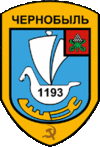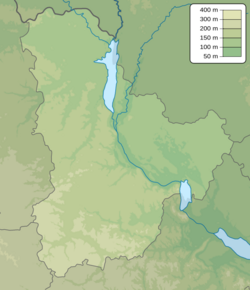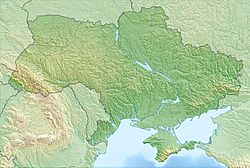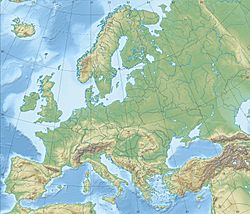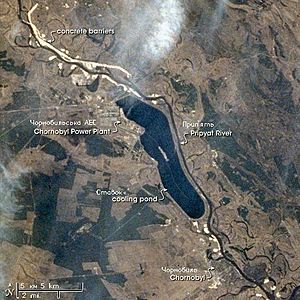Chernobyl facts for kids
Quick facts for kids
Chornobyl
Чорнобиль (Ukrainian)
|
||
|---|---|---|
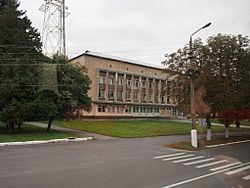
The Administrative Center in Chernobyl (2013)
|
||
|
||
| Country | ||
| Oblast | Kyiv Oblast | |
| Raion | Vyshhorod Raion | |
| First mentioned | 1193 | |
| City status | 1941 | |
| Abandoned | 1986 | |
| Named for | Artemisia vulgaris | |
| Government | ||
| • Body | State Agency of Ukraine on the Exclusion Zone Management | |
| Area | ||
| • Total | 25 km2 (10 sq mi) | |
| Population
(2020)
|
||
| • Total | ~150 (est.) | |
| Time zone | UTC+2 (EET) | |
| • Summer (DST) | UTC+3 (EEST) | |
| Postal code |
07270
|
|
| Area code(s) | +380-4593 | |
| ISO 3166 code | UA | |
Chernobyl, also known by its Ukrainian name Chornobyl, is a city in northern Ukraine. It is famous around the world for the Chernobyl disaster, a major nuclear accident that happened there in 1986.
The city is located inside the Chernobyl Exclusion Zone, a special area with restricted access. Before the accident, about 14,000 people lived in Chernobyl. After the disaster, everyone had to leave. Today, it is mostly a ghost town, although a small number of people work there in shifts to manage the Exclusion Zone.
Chernobyl is about 90 kilometres (60 mi) north of Kyiv, the capital of Ukraine. The city of Pripyat, which was built for the power plant workers, is very close but is completely abandoned.
Contents
What does the name Chernobyl mean?
The city's name, Chornobyl, is the Ukrainian word for a type of plant called Artemisia vulgaris, or mugwort. This plant is very common in the area. The name comes from two old words: chornyy (чорний), meaning "black," and byllo (билля), meaning "grass" or "stems."
A Long History
Chernobyl is a very old city. The first time it was mentioned in historical records was in 1193, when it was a hunting lodge for a prince. Over the centuries, it was part of different countries, including the Grand Duchy of Lithuania and the Kingdom of Poland.
A Center for Jewish Culture
In the 1700s, Chernobyl became an important center for Hasidic Judaism, a branch of the Jewish faith. A famous Hasidic leader, Rabbi Menachem Nachum Twersky, started a dynasty there. For a long time, a large Jewish community lived in the city.
Sadly, the community faced periods of great hardship and violence at the start of the 20th century. This caused many people to leave the city for safer places.
The Soviet Era
After 1921, Chernobyl became part of the Ukrainian SSR, which was one of the republics of the Soviet Union. During the 1930s, the people of Chernobyl suffered through a terrible famine known as the Holodomor.
During World War II, German forces occupied the city from 1941 to 1943. Tragically, the Jewish people who remained in the city were killed.
The Chernobyl Nuclear Power Plant
In the 1970s, the Soviet government decided to build a nuclear power plant just 15 kilometres (9 mi) away from Chernobyl. It was the first nuclear power plant in Ukraine. To house all the workers and their families, a new city called Pripyat was built nearby. The first reactor at the power plant started producing electricity in 1977.
The 1986 Chernobyl Disaster
On April 26, 1986, a major accident happened at the Chernobyl Nuclear Power Plant. During a safety test, Reactor No. 4 went out of control and exploded. The explosion and the fire that followed released a large amount of dangerous radioactive material into the air. This material spread over Ukraine, Belarus, Russia, and even parts of Europe.
It was the worst nuclear disaster in history.
Evacuation and the Exclusion Zone
A few days after the explosion, the Soviet government began to evacuate the people living in Pripyat and Chernobyl. Over 100,000 people had to leave their homes behind. They were moved to other cities, like the newly built city of Slavutych.
To keep people safe, the government created the Chernobyl Exclusion Zone. This is a large area around the power plant where nobody is allowed to live. The city of Chernobyl is inside this zone. Although average background radiation has returned to normal, "hot spots" of higher radiation still exist.
What is Chernobyl Like Today?
Today, Chernobyl is a quiet and overgrown city. While it is illegal to live there, it is not completely empty. Scientists, police, and workers who manage the Exclusion Zone stay in the city for short periods. There is a hotel, a post office, and a couple of small stores for them.
A Haven for Wildlife
With very few people around, nature has started to take over Chernobyl and the surrounding area. The forests are now full of animals. Many species, including wild horses, wolves, deer, and eagles, are now living in the Exclusion Zone. Scientists study these animals to see how they have adapted to the environment.
Some studies indicate that numerous species exhibit decreased life expectancy and increased mortality rates as a result of radiation exposure.
Geography
Chernobyl is located in northern Ukraine, near the border with Belarus. It sits on the Pripyat River, which flows into the larger Dnieper River. The area has a climate with warm summers and long, cold, and snowy winters.
Notable people
- Aaron Twersky of Chernobyl (1784–1871), rabbi
- Aleksander Franciszek Chodkiewicz (1776–1838), Polish politician
- Alexander Krasnoshchyokov (1880–1937), politician
- Andriy Smalko (1981–), football player
- Arnold Lakhovsky (1880–1937), artist
- Grigory Irmovich Novak (1919–1980), Jewish Soviet weightlifter
- Rozalia Lubomirska (1768–1794), Polish noblewoman
- Volodymyr Pravyk (1962–1986), firefighter who died responding to the Chernobyl disaster
Images for kids
See also
 In Spanish: Chernóbil para niños
In Spanish: Chernóbil para niños
- List of Chernobyl-related articles
- Pripyat
- Chernobyl disaster


